BBC's Blog, page 19
May 24, 2013
Online Briefing: The day in Tweets
Hi everyone. Today was the BBC Online Briefing, a chance for the BBC to share what it’s doing in all things digital with the wider industry.
Over the next couple of weeks we will be making videos from the day available on the blog so you’ll be able to check out what speakers from different departments of BBC Future Media presented.
I was in the Radio Theatre tweeting key quotes and pictures from the talks and sessions as well as collating others tweets and activity from participants on our Live blog.
Below are some of the highlights from the different sessions.
From director of Future Media Ralph Rivera’s Keynote speech:

From the Connected Studio session hosted by director Adrian Woolard and project manager Robin Cramp:
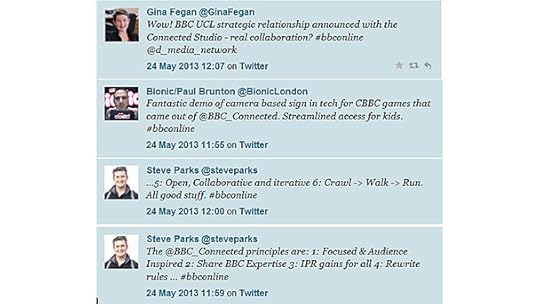
From the session CBBC & CBeebies and the Evolution of Games with product lead Patrick Healy and senior product manager Simon Lumb:

From Delivering Connected TV: The TV Application Layer session with technical product manager Peter Lasko and senior technical architect Paul Caporn:

From TV, PC, Mobile and Tablet: Reaching Viewers in the Four-Screen World of 2016 presentation with Julian Dickens:

From the Q&A with Ralph Rivera and director of Business Development
Jane Weedon
:

You can see more tweets from the day on the Live blog or the Internet blog twitter feed @bbcinternetblog and check back next week for the first of the videos.
Eliza Kessler is the content producer on the BBC Internet blog.
Live blog for Online Briefing
Hi everyone, today is the BBC Online Briefing in New Broadcasting House, London. This is a chance for the BBC to share the work it’s doing with partners and suppliers in the digital arena.
Host Kirsty Wark will have the opportunity to ask Future Media director Ralph Rivera some of your questions so if you have something you would like her to ask then leave a comment below, in Kirsty’s blog post or tweet us using the hashtag #BBCOnline.

Live blog for the BBC Online Briefing
We’ll be collating the news, discussions and opinions from the day using our Live blog so check it out, tweet your views and don’t forget to follow us on @bbcinternetblog.
Eliza Kessler is the content producer for the BBC Internet blog.
May 23, 2013
BBC Online Briefing: Work plan
It’s spring (at last) and BBC Online is gearing up for another BBC Online Briefing, the fourth in the series. As last year, we are in London in Radio Theatre, right next to the BBC’s new HQ in New Broadcasting House. The Briefing is being held tomorrow, Friday May 24.

A view of BBC Broadcasting House
The idea behind the Briefings is to share with a broad cross section of the UK digital media industry service and product plans as well as latest thinking on significant topics.
After feedback from delegates we are trying a few new things this year. As well as a round-up of what the Connected Studio has achieved, delegates will go into smaller groups so we can cover more topics in more detail and increase the opportunities for face to face encounters.
As always we are publishing BBC Online’s Workplan for the coming year. I hope this will give you a better idea about what we hope to achieve in the next twelve months.
We’re pleased to have secured Kirsty Wark of Newsnight as presenter and host. If you have a specific question you’d like to be asked at the Briefing, please leave a comment on Kirsty’s blog post.
The Briefing is by invitation only and we’ve filled up the Radio Theatre. If you want to follow events on the day then look for hashtag #BBCOnline and at the Internet blog’s live page. And, as last year, all the presentations and sessions will be videoed and published on the BBC Internet blog next week.
Andy Conroy is chief operating officer, BBC Future Media and Online.
New Sport Pilots from Connected Studio
Hi I’m the senior technology architect for BBC Sport Online. Regular readers of this blog will know that Connected Studio has been a hot topic over the past year with most areas of BBC Online having a turn.
It’s gone particularly well for my team, Sport, where 40 ideas from the initial sessions have been whittled down to the four strongest to take through to pilot stage. This blog summarises each of these projects and gives you the chance to let us know what you think.
Pilot phase means these projects have been prototyped for testing. This means, with the exception of Virtual Crowd at the Champions League final, we’re unable to offer them on the BBC Sport site. Hopefully, the descriptions of the pilots here provide enough to whet your appetite though.
Pilot One: Virtual Crowd by MadeByPi (indie)
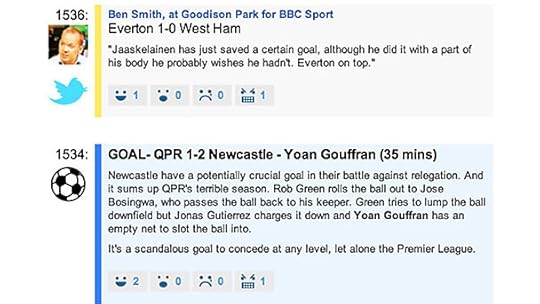
Share your views using the 'happy', 'shocked', 'sad' and 'angry' buttons against each live text entry
The Virtual Crowd pilot allows users to interact when live football matches are underway.
If you use the BBC Sport website or apps on a Saturday to access the latest football scores you’re probably not aware that you’re one of about a million doing so.
Virtual Crowd provides opportunities to share your feelings on a match or sport related incident with others on the site.
Users can pick answers to questions such as ‘Who do you think will win the Arsenal vs Manchester United match today’ by simply clicking a button. It’s simple and just takes a few moments to do.

See online attendance and choose your preferred team and outcome
The web pages then show the combined (aggregate) view of all who’ve taken part - the ‘virtual crowd’ - demonstrating the overall split of allegiances and support levels of fellow site visitors and fans.
Information gathered will also be delivered as data visualisations as part of the event coverage to provide a unique and playful archive of the nation’s sporting reactions.
On the evening of Saturday 25 May this pilot will be available for use during the Champions League final. There’ll be two pages that replicate pages on the BBC Sport site, but with extra ‘Virtual Crowd’ features. You will be able to access the pilots on the Connected Studio site and I will add a link on this post too.
Pilot Two: Pocket Pundit by Aerian Studios (indie)
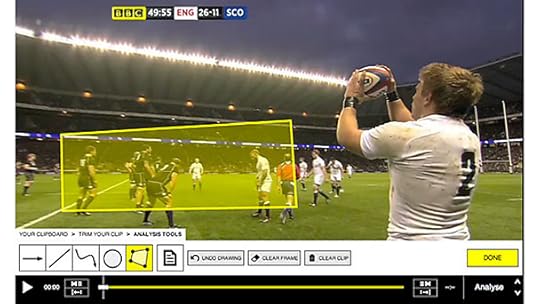
Add game analysis to BBC Sport video clips
Pocket Pundit adds analysis features to the Sport sites video player. Users can express their opinions on a sporting event by bookmarking, clipping and annotating selected video clips.
The concept provides a simple tool set similar to that used by pundits on TV. Users can then record and share their analysis with friends and other interested users via social media and on the BBC Sport site with an aim to generate debate and encourage interaction.
Pocket Pundit can work with any sport and can be used whilst the game is live or after in ‘catch-up’ mode.
Pilot Three: Sport Companion by Pobl Creative (indie)

Delve deeper into a football match or other sport event using a responsive, interactive page
A big question in the broadcast world is how to make use of the ‘second screen’ – the smartphone, tablet, or laptop that many have in their hands whilst watching TV.
The BBC Sport Companion provides a second screen experience to accompany live football matches you may be watching on TV. It also works when listening on the radio or on its own.
The companion provides a moment-by-moment view of the action offering rich stats and highlighting key events. The companion achieves this through clever use of data increasingly available at football matches, pinpointing the key action points in an event and in turn giving users a fuller, more entertaining experience as and when they want it.
BBC Sport Companion works across mobiles, tablets and computers and could also be expanded to sports other than football.
Pilot Four: Death of the Robot (BBC team)

Carefully selected tweets can provide great coverage of a football match or other sport
If you’ve been to a sporting event recently you may have noticed someone tweeting whenever something happened. Twitter has become an incredible source of coverage and opinion on sporting events big and small.
The Death of the Robot pilot brings the best sports coverage from Twitter to the BBC Sport website to enrich the live event experience, adding colour and vigour to the page to bring the stats to life.
The system has the ability to learn which tweets are most relevant and interesting for a particular football match or other sporting event. It then automatically provides the best tweets for every event.
These appear on every football match page alongside existing content such as the score, team information and match statistics. It adds an extra level of reporting, analysis, and opinion to these pages.
Performance is key for this project. WebSockets (powered by Node.js) are used to show tweets within seconds of them being made.
Penny for your thoughts?
So, over to you, which of these ideas appeal the most? The pilots have proved that all these ideas are achievable from a technology perspective. We’ll now start assessing whether they are of interest and relevance to the audience and while these are not the sole considerations we’d still be very interested to hear which ones you like via the comments.
Matthew Clark is the senior technology architect for BBC Sport Online.
You can read about the latest set of CBBC pilots on project manager Robin Cramps blog post.
May 22, 2013
Building the Knowledge & Learning Beta
Hi I'm Rob Lee, senior technical architect for Knowledge & Learning (K&L) at the BBC.
I'm part of the team building the new Knowledge & Learning product. In this post I'm going to describe the technical work we've undertaken so far, some of which you can see in the new Beta release that my colleague Chris Sizemore recently blogged about.

Video content on the Knowledge & Learning Beta
The Knowledge & Learning product aims to bring together the variety of factual and learning content we have on the BBC into a coherent proposition. In the formal learning space we currently have a number of sites including Bitesize, Skillswise and Class Clips amongst others.
There are tens of thousands of content items across these sites with each site having different mechanisms for publishing, discovering and describing the content it serves.
Rather than approach the development of the new product as a 'big-bang' exercise trying to incorporate everything at once, we've adopted an incremental approach to adding content and building out new functionality using short form audio and video clips as the first content type to surface in the Beta.
This meant the team had a well-defined problem to solve but still had to consider some key challenges inherent in building the new product:
Multi-device consumption: Many of the existing sites were built before smartphones and tablets became commonplace so a method of delivering content in a multi-device world was required.Content management and migration: Existing sites use a collection of content production systems to author content. We needed to rationalise these and define a content migration process. Information architecture and content modelling: Each of the existing sites have similar but different ways of describing and navigating to their content. We needed a consistent approach to describe content in the new product.
In each of these areas we tried to build on existing successes and key systems at the BBC, allowing the team to focus on delivering new product features.
Technical Overview
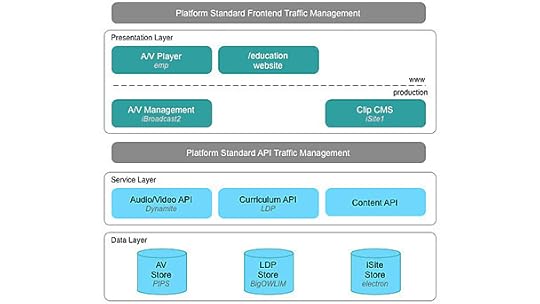
Architecture overview
The overview diagram above shows the components involved in the initial Beta release. The BBC has a standard platform for dynamic content rendering that follows a multi-tier approach, keeping a clear separation of concerns.
The rendering layer is built on a standard PHP framework (Zend) with BBC extensions for common capabilities and components. Access to the data layer is via Java service components with rendering components never communicating directly with the data layer.
Caching is a key feature of the stack with reverse proxy caches (Varnish) proxying requests through to the PHP page assembly (rendering) layer using standard HTTP caching mechanisms to allow caching of pages.
The service layer has a similar caching arrangement and both rendering and service layers have access to memcached which provides a distributed memory object caching system to applications.
Ensuring the Java service components are performing is key as these are aggregated in the page assembly layer, meaning the effects of a slow service component can be amplified when a series of requests are made from the page assembly layer.
Memcached is useful in this scenario however, we use caching carefully, where it will have the biggest impact as it adds another layer of indirection making failure modes more difficult to diagnose.
We've tried to keep the architecture simple in line with our initial goal for the Beta but with the longer term aims still in mind. I'll talk about some of the components involved in the diagram in the sections below.
Serving content in a multi-device world
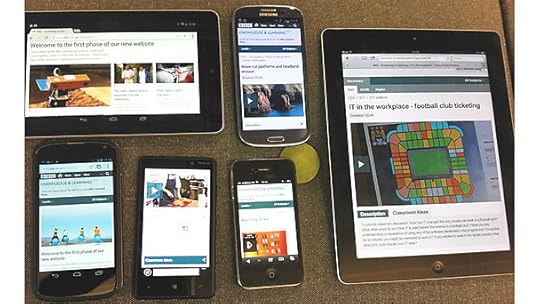
The Beta site across different devices
One of the emerging patterns in delivering content to the variety of devices people now use is Responsive Design, a way to build a single fluid experience that works across multiple devices rather than a series of separate disconnected designs.
This required a mobile first approach to design and implementation which was a new way of working for the team. One of the benefits that Responsive Design delivers is that when we build a new feature in the product it's available on release to all devices at the same time rather than having to add a feature for each device class.
We followed the responsive BBC News model of delivering a core experience to HTML4 browsers and an enhanced experience to HTML5 capable browsers that 'cut the mustard'. We use CSS3 media queries to support responsive styling for different viewports (screen sizes) and device orientations which, for example, allows font size on a large-screen tablet in landscape mode to be increased when compared to that on a smaller mobile device.
This has given us a framework for delivering all new Knowledge & Learning content in a responsive way which we can continue to improve and build on. This is still a work in progress and we're looking at ways we can improve our initial content footprint and the way we deliver assets.
We are one of the first collection of sites at the BBC to use the new Responsive Barlesque (ostensibly the header and footer used for every BBC page) called ORB. Using ORB made it easy to deliver a single fluid experience as it follows the same responsive principles as our application.
The responsive approach also makes it easier to use standard platform caching technologies to effectively manage increased site hits during busy times, such as exam revision times, as the product can deliver small cacheable HTML pages to clients with appropriate cache control information. This means the load on platform infrastructure can be kept to a minimum.
Content management and migration

Diagram showing the content management systems and how they interact with the site
Where appropriate we've used standard content production systems within the BBC allowing the team to concentrate on building out new functionality in the product.
For short form audio and video clips we use iBroadcast2 which provides a way to publish short form clips in a standard way so the content is available on as wide a selection of devices as possible when used in combination with the BBC media player (known as emp).
Using this system means we're part of the same media ecosystem that powers BBC pages like /programmes and BBC iPlayer meaning the product benefits from ongoing improvements.
For general content management we use iSite which is a standard content management system within the BBC and is also used to content manage the BBC Internet Blog, see Welcome to the new look Internet blog for more information.
With these core systems in place we set about planning the migration of the 10,000+ short form audio and video clips from the existing class clips site. There were a number of challenges we had to address in order to migrate the video and associated content:
Clip format: The clips were originally transcoded using systems primarily intended for content consumed on the desktop. This meant finding a way to re-encode the clips in the same formats produced by iBroadcast2.Clip content: The existing clips content (e.g. Classroom Ideas) was held in a legacy publishing system and needed to be extracted and placed alongside the clips published in iBroadcast2.Clip mappings: The curriculum information held against the existing clips (e.g. its subject or topic) needed to be mapped in the curriculum data model.
A simplified process flow for the clip migration is shown in the figure below:

Simplified clip migration process flow
The migration has three key steps:
The clip transcoding was carried out by the Media Publishing System (MPS) team who ingested the source clips, bulk processed them and added them to the same systems that iBroadcast2 publishes to, with clips transcoded to the same formats. This means in the future all clips (both migrated and newly added) can be editorially managed using iBroadcast2.
The K&L editorial teams then produced a series of controlled vocabularies which were mapped to each clip. The teams also validated the associated content for each clip, amending and rewriting where needed to ensure the content was suitable for the new product.
Finally, a transformation component was produced that took these inputs, generated XML documents, ready for addition to iSite so they could be rendered in the new Beta site.
Describing content

The curriculum ontology
Following on from the work on Dynamic Semantic Publishing we've adopted a similar approach, moving away from a relational publishing model to one that separates semantics from content and allows for easier re-use.
The existing learning sites have no single model to describe content that could be reused in the new product. The team therefore produced a model of the UK national curricula that allows description of all learning (and other) content in context. This model will contain over 2000 curriculum topics across the various key stages and levels.
The key classes in the model are:
Level: A stage of education e.g. KS3.Field of Study: A subject discipline of a curriculum e.g. Science.Topic: A more specific description of a learning resource in the context of a field of study e.g. Energy.Programme of Study: A combination of an educational Level and the Field of Study e.g. KS3 Science.Topic of Study: A Topic in the context of a Programme of Study e.g. KS3 Physics Energy.
As demonstrated in the diagram above, the model allows for modelling of complex relationships where both KS3 Physics and KS3 Geography share a common Topic 'Energy'.
We've released this model for others to use which you can find at the curriculum ontology page. The model is licensed under an open license meaning others can reuse and adapt it for their own purposes.
We'd be interested in any feedback or comments from anyone who adopts this model.
This curriculum data is held in the BBC's Linked Data Platform (LDP) expressed as Resource Description Framework (RDF) which will allow a learning context to be applied to many content items produced by the BBC in the future.
We've created an LDP-powered domain-specific API for the curriculum domain model, that powers each of the curriculum pages (e.g. the KS3 Geography Environment page) and the curriculum navigation on the site.
We're also aiming to expose this domain model as structured data in the content. In our next release we'll be adding in-page mark-up from the educational vocabulary in Schema.org which is contributed from the LRMI project.
Schema.org is a "collection of schemas, i.e. HTML tags, that webmasters can use to mark-up their pages in ways recognized by major search providers". LRMI is an education-specific vocabulary, providing a way to consistently describe educational content.
Practically this means that machines (such as search engines) will be able to index and understand more about the content from the structure, aiding it's discovery. We've created mappings between Schema.org and the curriculum ontology allowing us to expose the data in the curriculum ontology in a way that search engines (and others) can easily consume.
This mapping is still a work in progress and will evolve as Schema.org and LRMI evolve but we believe it's a useful way to begin exposing the semantics for learning content at the BBC
What's next?
We're currently working on adding more clips to the Beta site to give further coverage across the UK curricula. We're aiming to add localisation support for UK indigenous languages as well as adding new content formats to the site.
If you have any thoughts or queries that you’d like to feedback then please leave a comment below or email us at knowledgeandlearningfeedback@bbc.co.uk.
Robert Lee is senior technical architect for BBC Knowledge & Learning.
May 21, 2013
Now Pilot Technical Architecture
Hello there my name is David Wynne and I’m a technical architect and founder of Red Badger, a creative software workshop that has been working with the BBC to develop features such as BBC Now.
Through BBC Connected Studio we’ve been working closely with Eleni Sharp, BBC Homepage product manager and her team to design, test and develop the BBC Now pilot and you can read more about the feature in Eleni’s recent blog post.

The Challenge
Our challenge with BBC Now was to capture all the content being published both on bbc.co.uk and on other platforms and to bring it all together into a single unified stream of real-time push updates that are instantly delivered live to the BBC Homepage.
Broadly speaking this broke down into four technical challenges:
Monitoring for new content. Contextualising new content against a BBC brand (such as Top Gear). Pushing content out to the BBC Homepage in real-time. Aggregating common terms within the content to establish trending topics.
The Solution
Each type of datasource (RSS, Twitter, BBC iPlayer content etc) is monitored by a separate Content Processor. Each Content Processor identifies new content, transforms it into a standard structure, associates it to a BBC brand and publishes it to the Firehose.
The Firehose is an unadulterated, unified stream of all new content from every Content Processor. The Firehose allows for multiple subscribers who can use or transform the data and produce their own streams of content.
The primary subscriber to the Firehose is the BBC Homepage which surfaces each item of content as an update in the Fast Lane. The Fast Lane is a column on the Homepage that receives push updates, from the Firehose and displays them in chronological order.
The Trend Analysis module also subscribes to the Firehose and receives the same set of content. The Trend Analysis module extracts common terms from the published content and aggregates that content using those terms, creating categorised ‘buckets’ of content.
When the buckets are sorted the Trend Analysis Module produces a list of the most common terms appearing in content over a given period and facilitates content filtering.
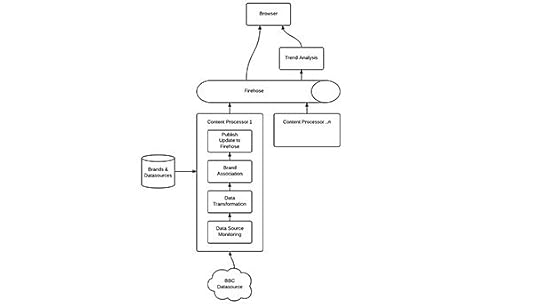
Flow diagram of BBC Now
The Tech
The heart of BBC Now is built using Node.js, a relatively new technology but one which has picked up huge momentum and for good reason. Node.js is a technology born of the web, for the web. It uses Google's V8 JavaScript engine on the server and an event loop to drive code execution. It allows scalable, real-time web applications, quickly.
BBC Now is built out of flat, independent modules making it easy to maintain and scale out. The thin layer of glue that holds them together is Redis. Redis is an advanced key-value store that, like Node, uses an event loop to drive execution and is both fast and scalable.
Redis also offers a fast and scalable implementation of the Publish/Subscribe (or pub/sub) messaging pattern. A pub/sub implementation allows publishers (in this case our Content Processors) to publish data without needing to know how it is delivered to other parts of the application.
Conversely the subscribers (in this case the BBC Homepage & Trend Analysis module) can subscribe to topics of data without needing to know which other part of the application produced it. They simply react to new data as it’s published.
This separation of concerns encourages each part of the application to concentrate on their single responsibility, which in turn means the system as a whole becomes easier to scale and reconfigure.
In essence, BBC Now is all about subscribing to data and publishing it elsewhere making Redis a perfect partner.
In designing the real-time push updates to the BBC homepage we had a few options.
This most traditional method of polling, whereby the client (your browser) periodically asks to the server (the BBC homepage) for updates, seemed like a poor choice. Most of the work we had put in was to convert passive data sources into active ones, returning them to a passive data source seemed to be heading in the wrong direction.
WebSockets, a relatively new technology that allows a constant two-way conversation between client and server (think of an instant message conversation), seemed like an obvious choice. But would have perhaps been a bit overkill given we only needed one-way communication.
Server-sent Events (SSE) provided the perfect lightweight middle ground. SSE are expressly designed for providing push notifications from a server to a browser client and have wide browser support (apart from IETM). SSE operate over HTTP (unlike Websockets) which means that JavaScript polyfills can be employed to bridge the gap for older browsers which don’t natively support the mechanism.
The Future
Besides further feature development (more data sources, personalisation, mobile) we’d love to dovetail our work with that of the BBC Linked Data Platform team which would provide a wealth of contextualised data that would really push us onto the next level.
I’d love to chat more about BBC Now – please leave a comment below or you can catch me on Twitter @dwynne or via the #bbcnow hashtag.
David Wynne is a technical architect and founder of Red Badger.
May 20, 2013
BBC Online Briefing: Your questions
Last year I hosted an internal BBC staff event for the BBC’s Future Media division.
There was a great atmosphere in the studio theatre and I hope everyone felt it was a valuable and relaxed day. Obviously there’s been a regime change since then, but if I’m reading the mood music correctly the BBC wants more conversation, more sharing and more candour! So....
I’m pleased to say that on the 24 May I will be hosting the fourth BBC Online Briefing at the Radio Theatre in Broadcasting House in London.

Radio Theatre at BBC Broadcasting House
If you’re a regular reader of the Internet blog you’ll know that this is an annual event for BBC Online and BBC Red Button. It’s where the BBC gives something back by sharing the work it’s doing with partners and suppliers in the world of digital. For example on Friday there’ll be a showcase for some of the work done by Connected Studio in the past year.
You can read blog posts and watch videos of last year’s event on the BBC Commissioning website.
The event is invite only and is fully booked, but there will be livetweeting (please use the hashtag #BBCOnline if you want to tweet) and a live page where if you’re not attending you can watch a selection of tweets and photos on the day.
And please contribute! At the end of the day I’ll be asking Ralph Rivera, director of BBC Future Media and Jane Weedon, controller of Business Development, for questions from the floor. If you have a question you’d like me to ask Ralph and James please comment on this blog post and I’ll add your questions into the mix.
So if you’re coming I’ll see you there and if not and you want to ask a question, please do leave a comment.
Kirsty Wark is a presenter and journalist.
May 17, 2013
What's on BBC Red Button - May 18-25
A varied and exciting smorgasbord of musical delights on the Red Button this week. Yes, it’s Eurovision in all its glory with Radio 2’s Ken Bruce giving his take on the proceedings.
Radio 1’s Big Weekend begins on Friday in Derry-Londonderry, this year’s City of Culture and lovers of all things gardening-related can tune into the Chelsea Flower Show for commentary from designers and a tour of the show gardens.
Eurovision Song Contest
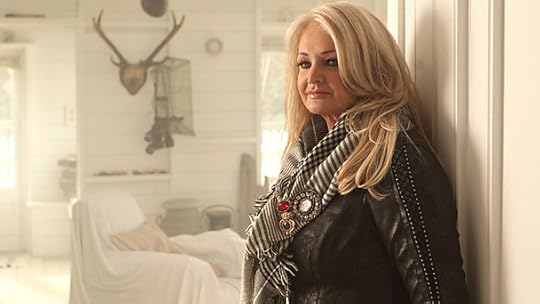
Bonnie Tyler
It’s that time of year and once again viewers can press the red button during Eurovision for an interactive experience including sing-along onscreen lyrics in both English and the native language and an optional alternative commentary from Ken Bruce on BBC Radio 2. We’ll also be displaying some of your comments and Eurovision party photos from Facebook, Twitter and SMS*. Please use #bbceurovision and visit bbc.co.uk/eurovision for more.
*See bottom of blog for terms & conditions
Available on Freesat/Sky/Virgin Media/Freeview
Sat 18 May, 7.55pm-11.:15pm
RHS Chelsea Flower Show 2013

RHS Chelsea Flower Show
Toby Buckland hosts the BBC’s Red Button giving tours of some of this year's larger show gardens,including detailed commentary from the designers on the inspiration and motivation behind their spectacular designs.
In addition, horticultural haymakers Tom Hart Dyke and Christine Walkden will be sharing tales from the vast treasure trove that is the Great Pavilion, speaking to the passionate exhibitors who have been working for weeks, months and sometimes years in preparation for the week-long floral extravaganza.
Available on Freesat/Sky/Virgin Media/Freeview
Mon 20 May, 12.00pm-6.00am
Tue 21 May, 6.00am-2.15pm, 5.50pm-6.00am
Wed 22 May, 6.00am-6.00am
Thu 23 May, 6.00am-10:.5pm
Fri 24 May, 4.00am-6.00am, 6.00am-11.00am, 12.00pm-8.00pm
Sat 25 May, 2.15am-6:00am
Radio 2 In Concert - Rod Stewart
Available on Freesat/Sky/Virgin Media/Freeview
Sat 18 May, 6.00am-11.20am, 7.00pm-7.55pm
Sun 19 May, 10.30pm-1.00am
Dr Who
Available on Freesat/Sky/Virgin Media/Freeview
Sat 18 May, 5.00pm-7.00pm
Antiques Play Along Quiz
Sun 19 May, 7.25pm-8.30pm
R1 Big Weekend 2013

Rita Ora to play Radio 1's Big Weekend in Derry-Londonderry
Radio 1’s Big Weekend is live from Derry-Londonderry. On Friday 24 May, press the red button between 8pm and 2am – to watch bands from the Main Stage and 1Xtra Arena. You’ll see Maverick Sabre, Aluna George, Rudimental, Dizzee Rascal, Angel Haze, Katy B, Chase & Status, Rita Ora, J. Cole, Wiley and A$AP Rocky - and the Main Stage Headliner is Calvin Harris.
Available on Freesat/Sky/Virgin Media/Freeview
Fri 24 May, 8.00pm-2.15am
Sport
Football Focus – Last day of the season. (Who will take 4th spot?)
Diamond League action from Shanghai – Team GB medalists Greg Rutherford and Robbie Grabarz are in action.
MotoGP – MotoGP qualfying session and the Moto2 and Moto3 races live on the Red Button from Le Mans.
For the latest information, refer to the BBC Sport website
Please note all Red Button times are subject to change at short notice.
Eurovision Song Contest Terms & Conditions
By sending a message, sender agrees: (i) to allow the BBC to publish the comments and pictures, in any relevant platform; (ii) that the sender has obtained consent from all individuals appearing in any photos for the photo to be used by the BBC; and (iii) that the sender and (ie not a third party) has the right to publish such picture.
The BBC reserves the right to select only some of the messages and pictures for publication. Messages or pictures of indecent or offensive nature will not be considered.The BBC accepts no responsibility for any technical failure or malfunction which could result in a message being lost or misrouted or a billing error by the mobile operator.The personal data about you will be processed in accordance with the Data Protection Act 1998. For further information on how the BBC deals with personal information, please see bbc.co.uk/privacy
Please obtain bill payer's consent before sending the SMS. If you are under the age of 16, you must obtain your parent's permission before submitting your comment/photo.
No images of children under 13 (or appearing to be under 13) will be shown.
The BBC may need to edit your contribution for technical or operational purposes.
College of Production Roundup: Sound of 2013 and writing for online
I’m Ben Toone, assistant content producer at the BBC College of Production (CoP) website.
Our site is a free online learning resource for the radio, television and online production community offering videos, podcasts and articles from broadcasting innovators and experts.
Laura Mvula, Chvurches, Haim – sound familiar? If not, you’ve probably heard of Dizzee Rascal, Jessie J, Adele and 50 Cent. All have featured in the BBC’s Sound of Poll, an annual multi-platform project bringing the next big thing in music to those in the know in the music industry.
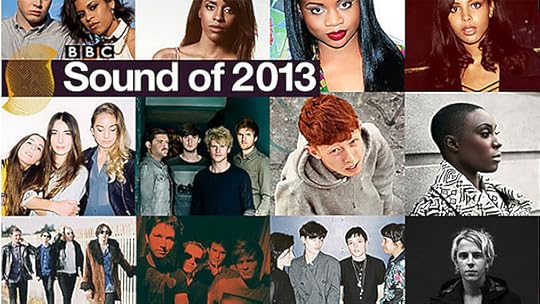
BBC Sound of 2013
The producer of this year’s Sound of 2013 Kate Holder took us through how she pushed the project further onto as many platforms and channels as she could, from the website itself and BBC Red Button to BBC News radio, TV and online and almost every BBC radio network from Radio 1 through to Radio 4’s Woman’s Hour. The bar is certainly set high for next year!
I’m being very careful what I write here because our next #CoPWorkshop, a live Twitter Q&A, is on writing online next Tuesday (1-2pm).
TV and radio producers and researchers are increasingly finding themselves having to write copy for online audiences, which certainly is a different kettle of fish to writing for television or radio. Whether it’s writing for a programme website, a Tweet or Facebook post or even a blog post (like this!), getting noticed and putting the right message across is more important than ever.
So I’ll be taking note of Mike Kibblewhite’s tips. Mike is currently a producer for the BBC Academy’s Fusion project and has to write engaging copy every day, but he’s also an experienced online producer for BBC Lab UK, BBC History and the BBC Food websites. Like all of our #CoPWorkshops, he’ll be personally answering questions directly on Twitter during the course of the hour as well as giving his tips and useful links.
So if you have any questions, from setting the right tone to structuring your copy, do join us by tweeting @BBCCoP #CoPWorkshop. As ever, we’ll Storify the workshop and keep a record on our website.
New CBBC pilots from BBC Connected Studio
Hello BBC Internet blog! I’m Robin Cramp, the project manager for BBC Connected Studio and welcome to the first of many blogs providing insight into the pilots we’ve taken forward as part of the year one of the programme.
My colleague (my way of saying boss without actually saying it) Adrian Woolard set the scene in his recent blog post suggesting that my next series of posts will be "rather entertaining as well as informative".
I can manage the well informed bit but the entertaining element is slightly more subjective. Let’s give it a bash.
Whilst the ‘day job’ sees me as the PM for Connected Studio I have picked up the additional role of event MC along the way.
If you’ve been involved you’ll understand how I endeavour to keep the pace up throughout the day by throwing sweets in an unorthodox fashion, garnering support through raised hands and shouting yeah, yeah, c’mon all too often. All in the vain hope that we can make the Connected Studio events as informative and fun as possible, especially during those potentially nerve racking pitching session that teams go through.
The events and jumping around is just one facet of my role, with principle responsibility to get the pilots that are successfully chosen from each of the Connected Studios realised.
We’ll be making some of the earlier pilots public very soon for you to test and play with but in the meantime here’s a sneak insight into the three pilots being developed for CBBC.

EEZL
EEZL by Peekabu (indie)
This pilot addresses the desire for increased sign-in to the CBBC website whilst encouraging more children to get involved in online activities.
When registering for an account, users will be prompted to draw a picture, either on the site with a web (or tablet) app or in the real world using paint and paper. In turn they create an account using that image.
To sign-in, they just hold their picture up to their webcam and the EEZL system recognizes the image and signs them in automatically, without the child needing to remember complex passwords or usernames.
Now I hear you saying ‘anyone could just draw a picture and login into my account’ well rest assured that the team over at Peekabu have thought that through and have some fool proof ways to ensure that doesn’t happen, quite cool!
In addition, adding friends is a simple as snapping a photo of their drawing and them doing the same for yours. The resulting process is fast, fun, works on any device with a camera (or upload functionality), avoids tricky mobile keyboards and makes a reliable authentication token out of the art that hangs on the fridge.

Predicto Machino
Predicto Machino by MadeByPi (indie)
Predicto Machino with the help of Hacker, star of CBBC show Hacker Time, makes far-fetched and comedic predictions about the user which they are invited to correct.
By doing this they build an anonymous profile of themselves which is stored in a cookie or optionally against a BBC iD login which then informs recommendations for other CBBC content they may like.
Animation, sound effects and voice-overs are used to entertain and encourage children to continue to interact ( as long as the talent isn’t committed to be in Hollywood during the build, just one of the real life realities presented to pilots teams) whilst a set of freshly generated content is displayed to the user each time they correct a prediction.
At any point the user can click on the suggested content links to visit other pages on the CBBC site. The user can return to the application in the future where they can continue to interact with the questions or view more suggested content.
The pilot provides a fresh way for the audience to find new content through the playful tool that is Predicto Machino.

Music Mashup
Music Mashup by Young (indie)
Now these guys from Manchester based Young have some amazing knitwear, enough to brighten anyone’s day. I’m a sucker for good jumpers and the team didn’t disappoint when they presented their Music Mashup idea.
Music Mashup is a visual and audio sequencer with a library housing 100's of clips from CBBC programmes and unique animations which users can ‘mash-up’.
Once the user has loaded the tool up with content by dragging and dropping in their chosen combination of clips they can change the sequences, swap videos and add effects.
For example, a clip of Tracy Beaker slamming a door could become a 'looping drum beat while a line from Diddy Dick and Dom would be a vocal sample.
When they save their creations it will automatically create a short music video to accompany their Mash Up that users can view, share and 'like' within the Mash Up chart.
The Music Mash Up game caters for both a younger and older demographic, allowing those with a higher ability level to be more creative with their sequencer. The team will ensure that even the most ‘creative’ child can make wonder sounding Music Mashups.
These three projects all came from the CBBC Connected Studio, next week we will take a look at BBC Sport where four ideas were taken into pilot stage.
Robin Cramp is the project manager for BBC Connected Studio.
BBC's Blog
- BBC's profile
- 28 followers



